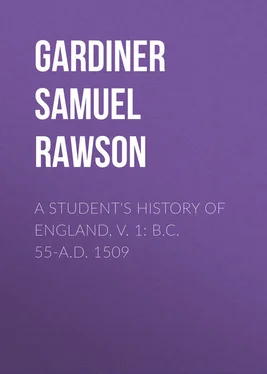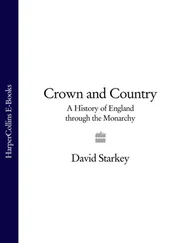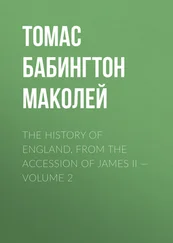Samuel Gardiner - A Student's History of England, v. 1 - B.C. 55-A.D. 1509
Здесь есть возможность читать онлайн «Samuel Gardiner - A Student's History of England, v. 1 - B.C. 55-A.D. 1509» — ознакомительный отрывок электронной книги совершенно бесплатно, а после прочтения отрывка купить полную версию. В некоторых случаях можно слушать аудио, скачать через торрент в формате fb2 и присутствует краткое содержание. Издательство: Иностранный паблик, Жанр: foreign_prose, История, foreign_antique, на английском языке. Описание произведения, (предисловие) а так же отзывы посетителей доступны на портале библиотеки ЛибКат.
- Название:A Student's History of England, v. 1: B.C. 55-A.D. 1509
- Автор:
- Издательство:Иностранный паблик
- Жанр:
- Год:неизвестен
- ISBN:нет данных
- Рейтинг книги:5 / 5. Голосов: 1
-
Избранное:Добавить в избранное
- Отзывы:
-
Ваша оценка:
- 100
- 1
- 2
- 3
- 4
- 5
A Student's History of England, v. 1: B.C. 55-A.D. 1509: краткое содержание, описание и аннотация
Предлагаем к чтению аннотацию, описание, краткое содержание или предисловие (зависит от того, что написал сам автор книги «A Student's History of England, v. 1: B.C. 55-A.D. 1509»). Если вы не нашли необходимую информацию о книге — напишите в комментариях, мы постараемся отыскать её.
A Student's History of England, v. 1: B.C. 55-A.D. 1509 — читать онлайн ознакомительный отрывок
Ниже представлен текст книги, разбитый по страницам. Система сохранения места последней прочитанной страницы, позволяет с удобством читать онлайн бесплатно книгу «A Student's History of England, v. 1: B.C. 55-A.D. 1509», без необходимости каждый раз заново искать на чём Вы остановились. Поставьте закладку, и сможете в любой момент перейти на страницу, на которой закончили чтение.
Интервал:
Закладка:
6. The Archbishopric of Canterbury.—After a short stay Augustine revisited Gaul and came back as Archbishop of the English. Æthelberht gave to him a ruined church at Canterbury, and that poor church was named Christ Church, and became the mother church of England. From that day the Archbishop's See has been fixed at Canterbury. If Augustine in his character of monk led men by example, in his character of Archbishop he had to organise the Church. With Æthelberht's help he set up a bishopric at Rochester and another in London. London was now again an important trading city, which, though not in Æthelberht's own kingdom of Kent, formed part of the kingdom of Essex, which was dependent on Kent. More than these three Sees Augustine was unable to establish. An attempt to obtain the friendly co-operation of the Welsh bishops broke down because Augustine insisted on their adoption of Roman customs; and Lawrence, who succeeded to the archbishopric after Augustine's death, could do no more than his predecessor had done.
7. Death of Æthelberht. 616.—In 616Æthelberht died. The over-lordship of the kings of Kent ended with him, and Augustine's church, which had largely depended upon his influence, very nearly ended as well. Essex relapsed into heathenism, and it was only by terrifying Æthelberht's son with the vengeance of St. Peter that Lawrence kept him from relapsing also. On the other hand, Rædwald, king of the East Anglians, who succeeded to much of Æthelberht's authority, so far accepted Christianity as to worship Christ amongst his other gods.
8. The Three Kingdoms opposed to the Welsh.—Augustine's Church was weak, because it depended on the kings, and had not had time to root itself in the affections of the people. Æthelberht's supremacy was also weak. The greater part of the small states which still existed—Sussex, Kent, Essex, East Anglia, and most of the small kingdoms of central England—were no longer bordered by a Celtic population. For them the war of conquest and defence was at an end. If any one of the kingdoms was to rise to permanent supremacy it must be one of those engaged in strenuous warfare, and as yet strenuous warfare was only carried on with the Welsh. The kingdoms which had the Welsh on their borders were three—Wessex, Mercia, and North-humberland, and neither Wessex nor Mercia was as yet very strong. Wessex was too distracted by conflicts amongst members of the kingly family, and Mercia was as yet too small to be of much account. North-humberland was therefore the first of the three to rise to the foremost place. Till the death of Ælla, the king of Deira, from whose land had been carried off the slave-boys whose faces had charmed Gregory at Rome, Deira and Bernicia had been as separate as Kent and Essex. Then in 588Æthelric of Bernicia drove out Ælla's son and seized his kingdom of Deira, thus joining the two kingdoms of Deira and Bernicia (see p. 36) into one, under the new name of North-humberland. 2
9. Æthelfrith and the Kymry.—In 593, four years before the landing of Augustine, Æthelric was succeeded by his son Æthelfrith. Æthelfrith began a fresh struggle with the Welsh. We know little of the internal history of the Welsh population, but what we do know shows that towards the end of the sixth century there was an improvement in their religious and political existence. The monasteries were thronged, especially the great monastery of Bangor-iscoed, in the modern Flintshire, which contained 2,000 monks. St. David and other bishops gave examples of piety. In fighting against Æthelfrith the warriors of the Britons were fighting for their last chance of independence. They still held the west from the Clyde to the Channel. Unhappily for them, the Severn, the Dee, and the Solway Firth divided their land into four portions, and if an enemy coming from the east could seize upon the heads of the inlets into which those rivers flowed he could prevent the defenders of the west from aiding one another. Already in 577, by the victory of Deorham (see p. 35), the West Saxons had seized on the mouth of the Severn, and had split off the West Welsh of the south-western peninsula. Æthelfrith had to do with the Kymry, whose territories stretched from the Bristol Channel to the Clyde, and who held an outlying wedge of land then known as Loidis and Elmet, which now together form the West Riding of Yorkshire.
10. Æthelfrith's Victories.—The long range of barren hills which separated Æthelfrith's kingdom from the Kymry made it difficult for either side to strike a serious blow at the other. In the extreme north, where a low valley joins the Firths of Clyde and Forth, it was easier for them to meet. Here the Kymry found an ally outside their own borders. Towards the end of the fifth century a colony of Irish Scots had driven out the Picts from the modern Argyle. In 603their king, Aedan, bringing with him a vast army, in which Picts and the Kymry appear to have taken part, invaded the northern part of Æthelfrith's country. Æthelfrith defeated him at Degsastan, which was probably Dawstone, near Jedburgh. 'From that time no king of the Scots durst come into Britain to make war upon the English.' Having freed himself from the Scots in the north, Æthelfrith turned upon the Kymry. After a succession of struggles of which no record remains, he forced his way in 613to the western sea near Chester. The Kymry had brought with them the 2,000 monks of their great monastery Bangor-iscoed, to pray for victory whilst their warriors were engaged in battle. Æthelfrith bade his men to slay them all. 'Whether they bear arms or no,' he said, 'they fight against us when they cry against us to their God.' The monks were slain to a man. Their countrymen were routed, and Chester fell into the hands of the English. The capture of Chester split the Kymric kingdom in two, as the battle of Deorham thirty-five years before had split that kingdom off from the West Welsh of the south-western peninsula. The Southern Kymry, in what is now called Wales, could no longer give help to the Northern Kymry between the Clyde and the Ribble, who grouped themselves into the kingdom of Strathclyde, the capital of which was Alcluyd, the modern Dumbarton. Three weak Celtic states, unable to assist one another, would not long be able to resist their invaders.
11. The Greatness of Eadwine.—Powerful as Æthelfrith was, he was jealous of young Eadwine, a son of his father's rival, Ælla of Deira. For some years Eadwine had been in hiding, at one time with Welsh princes, at another time with English kings. In 617he took refuge with Rædwald, the king of the East Angles. Æthelfrith demanded the surrender of the fugitive. Rædwald hesitated, but at last refused. Æthelfrith attacked him, but was defeated and slain near the river Idle, at some point near Retford. Eadwine the Deiran then became king over the united North-humberland in the place of Æthelfrith the Bernician, whose sons fled for safety to the Picts beyond the Forth. Eadwine completed and consolidated the conquests of his predecessors. He placed a fortress, named after himself Eadwinesburh, or Edinburgh, on a rocky height near the Forth, to guard his land against a fresh irruption of Scots and Picts, such as that which had been turned back at Degsastan. He conquered from the Kymry Loidis and Elmet, and he launched a fleet at Chester which added to his dominions the Isle of Man and the greater island which was henceforth known as Anglesea, the island of the Angles. Eadwine assumed unwonted state. Wherever he went a standard was borne before him, as well as a spear decorated with a tuft of feathers, the ancient sign of Roman authority. It has been thought by some that his meaning was that he, rather than any Welshman, was the true Gwledig, the successor of the Duke of the Britains ( Dux Britanniarum ), and that the name of Bretwalda, or ruler of the Britons, which he is said to have borne, was only a translation of the Welsh Gwledig. It is true that the title of Bretwalda is given to other powerful kings before and after Eadwine, some of whom were in no sense rulers over Britons; but it is possible that it was taken to signify a ruler over a large part of Britain, though the men over whom he ruled were English, and not Britons.
Читать дальшеИнтервал:
Закладка:
Похожие книги на «A Student's History of England, v. 1: B.C. 55-A.D. 1509»
Представляем Вашему вниманию похожие книги на «A Student's History of England, v. 1: B.C. 55-A.D. 1509» списком для выбора. Мы отобрали схожую по названию и смыслу литературу в надежде предоставить читателям больше вариантов отыскать новые, интересные, ещё непрочитанные произведения.
Обсуждение, отзывы о книге «A Student's History of England, v. 1: B.C. 55-A.D. 1509» и просто собственные мнения читателей. Оставьте ваши комментарии, напишите, что Вы думаете о произведении, его смысле или главных героях. Укажите что конкретно понравилось, а что нет, и почему Вы так считаете.












